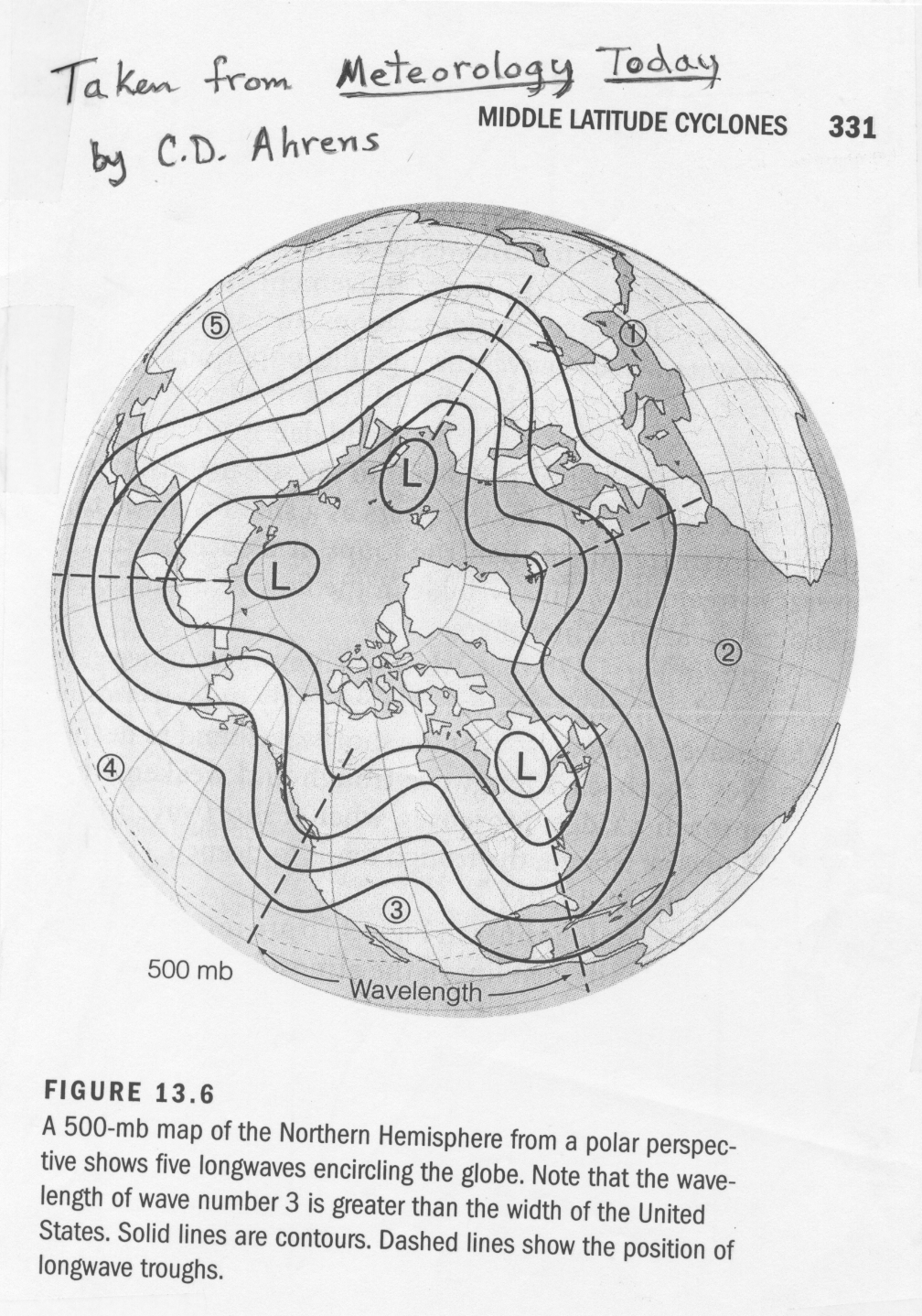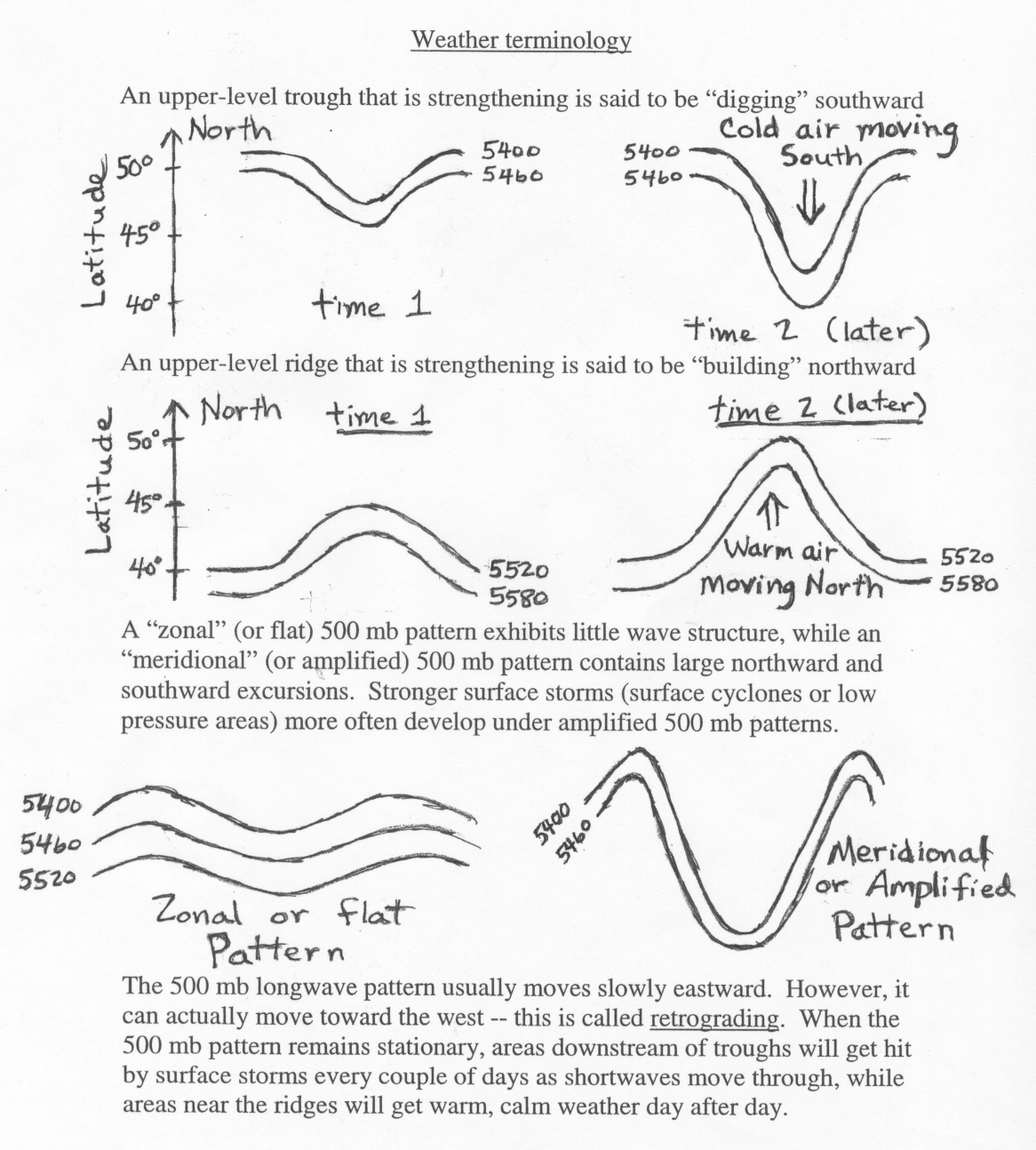This page reviews and expands upon what we have already covered. Some of it corresponds to some common weather terminology used by forecasters. The height pattern on a 500 mb upper air map can often be used to estimate the the large scale weather conditions at the surface. The simple analysis presented here does not explain everything that may be going on with the weather, especially at small spatial scales, but is very good at providing a snap shot or picture of the general weather conditions over large areas. It will work best in the wintertime in the middle and high latitude regions of the Earth. Thus analysis of a 500 mb height map provides a nice way to "see" the large-scale weather pattern over the United States, or even the entire Northern Hemisphere (see figure below), in winter.
 |
First, recall that the height of the 500 mb surface is related to the (density averaged) temperature of the atmosphere below 500 mb -- the higher the temerature, the higher the height of the 500 mb level. Consider what the 500 mb pattern would look like if temperatures decreased steadily from the equator toward the north pole. In that case the height contours would be concentric circles around the north pole with the highest heights to the south (toward the equator). While this is generally true, the actual pattern at any given time is wavy. See figure 13.6 above. Where the height lines bow northward (a ridge), warm air has moved north; and where the height lines bow southward (a trough), cold air has moved south. Therefore, in general warmer than average temperatures can be expected underneath ridges and colder than average temperatures can be expected underneath troughs. The more pronounced the ridge (or trough), the more above (or below) average the temperatures will be, i.e., the larger the amplitude of a 500 mb wave pattern, the greater the temperature contrast between trough and ridge.
You will notice that the caption for figure 13.6 above refers to the waves in the 500 mb pattern as longwaves. These are the waves that define the large-scale weather pattern (see figure 5). There are usually between 2 and 7 longwaves that encircle the Northern Hemisphere at any given time. The sample map above has 5 longwaves, labeled as 1 - 5. The average size of a longwave is a few thousand km or about the width of the United States. This size explains why we often see a pattern where it is warm in the Eastern U.S., but cold in the Western U.S., or vice versa warm in the West and cold in the East, because half of the country is under the ridge of a longwave, while the other half in a trough.
The 500 mb pattern can also be used to locate where surface storms and precipitation are most likely to be occurring. Surface storms and precipitation are most often found over areas downstream of troughs (following the horizontal wind direction from a trough to a ridge). The reason for this is that rising air motion is forced in this part of the flow pattern. Rising motion means that surface air is forced to move upward toward the tropopause. In the atmosphere, clouds and precipitation develop where air rises. Thus, we try to use weather maps to pick out areas where air is forced to rise upward, as these are places where precipitation may be occurring. Conversely, sinking air motion is forced over areas downstream of ridges. Clouds do not develop where air is sinking. Underneath these areas fair weather is most likely. By looking at a 500 mb map, you should be able to distinguish where precipitation is most likely and where fair weather is most likely.
The reason that rising motion occurs just downstream of 500 mb troughs is that in this region divergence of air occurs in the upper troposphere, while just downstream of ridges, sinking motion occurs as a result of convergence of air in the upper troposphere. Divergence occurs when horizontal winds cause a net outflow of air from a region (more air leaving a vertical column of air than entering), while convergence occurs when horizontal winds cause a net inflow of air into a region (more air entering a vertical column than leaving it). Take a look at this document on dynamical lifting of air to help you to understand what is meant by divergence and convergence, and why divergence in the upper troposphere forces air in a vertical column to rise, while convergence in the upper troposphere forces air in a vertical column to sink. You are not expected to understand why upper level divergence and convergence occur downstream of upper level troughs and ridges respectively, just that it does.
 |
Because the 500 mb pattern is often a good indicator of what is going on at the surface, much common weather terminology has arisen to describe it. Some of this terminology is depicted on the figure above. A few additional comments will be given here. The amount of precipitation that occurs with a winter-type storm depends on two main factors: atmospheric dynamics (how strongly air is forced to rise) and the availability of water vapor. Keep in mind that if the air does not contain sufficient water vapor, then no matter how forcefully it rises, clouds and precipitation will not form. On the other hand, if the air contains a lot of water vapor, then it does not take much lifting before clouds and precipitation will form. The stronger the divergence of air in the upper troposphere, the stronger air is forced to rise. The shape of a 500 mb trough often indicates something about its dynamical strength, i.e., its potential to force strong rising motion in the atmosphere and hence strong areas of precipitation. Below is a list of several things to look for in 500 mb pattern that act to increase divergence and hence rising motion. Link to Hand-drawn pictures for the items in the list.
In addition to the longwave pattern of 500 mb heights mentioned above, there are often smaller wiggles or waves that are superimposed on the longwave pattern. These are called shortwaves. There are shortwave troughs and shortwave ridges. These indicate smaller regions of warm/cold temperature contrasts and forced rising or sinking vertical air motions. Because they are much smaller than longwaves, shortwave troughs often have a much sharper curvature than longwaves and hence stronger divergence and forced rising motion. Thus, shortwaves can indicate the position of a strong weather system especially if it is sharply curved. Shortwaves typically flow through the longwave pattern following the longwave wind direction but at a slower speed. (As a rule of thumb, shortwaves move along at about one-half the speed of the 500 mb winds). Shortwaves tend to strengthen as they move into the region just downstream of a longwave trough and weaken as they move into the region just downstream of a longwave ridge. Figure 4 (top half) is a simple drawing showing what shortwave troughs look like in the 500 mb pattern.
If you compare 500 mb maps with where precipitation is falling, you will see that it generally is not raining (or snowing) everywhere downwind of troughs. Often the precipitation gets concentrated near a shortwave trough, then moves along with the shortwave. You may also notice small areas of precipitation just downwind of longwave ridges (where you didn't expect to see it). This again can be associated with a shortwave trough. Weather forecasters sometimes refer to shortwave troughs as "pieces of energy", "little disturbances in the flow", or "pockets of colder air aloft". This terminology arises from the fact that shortwave troughs often bring periods of precipitation.
Shortwaves come in a wide range of sizes and shapes. If a shortwave is large enough, you can easily locate it on a 500 mb height map by looking for little wiggles in the height pattern, but sometimes they are too small to see.
Although I have spoken most about troughs and ridges, it is fairly common to see closed lows (and closed highs) in the 500 mb height pattern. A closed low on a 500 mb map is a region surrounded by one or more circular height contours (with the lowest heights found in the middle). The air flows in a counterclockwise rotation around the closed low. The closed low indicates a pool of cooler air surrounded by warmer air. Three closed lows are shown in figure 13.6 above.
When a closed low becomes completely detached from the main westerly wind currents at 500 mb, it is called a cutoff low because it is cutoff from the main steering winds. A good example of a cutoff low centered just south of San Diego is shown on this map from fall 2005 (sample 500 mb map containing a cutoff low). Cutoff lows may remain detached from the westerlies for days while exhibiting very little forward (eastward) progress. In some instances, a cutoff low may move to the west, or retrograde, opposite to the prevailing flow. It is usually very difficult to predict the movement and evolution of cutoff lows. Often they move very little and over a period of several days eventually weaken and dissipate.
Cutoff lows often form when a 500 mb trough "pinches off" (see Figure 4 (bottom half)). As the cutoff low pinches off, the clouds and precipitation found downstream of the 500 mb trough can be wrapped around low by the counterclockwise winds. Thus, when cutoff lows sit over a given region, they often bring a prolonged period of cool, cloudy weather with intervals of rain or snow.
500 mb map for 00Z, Thursday, October 28, 2004
High temperatures relative to average for Wednesday, October 27, 2004
Weather conditions at 00:28Z, Thursday, October 28, 2004